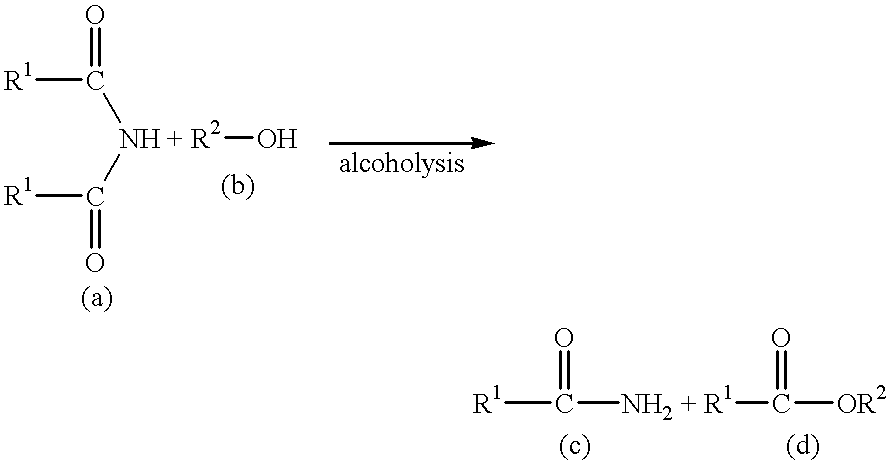Process for producing saturated aliphatic carboxylic acid amide
a carboxylic acid amide and saturated aliphatic technology, applied in the preparation of carboxylic acid amides, organic chemistry, organic compound preparations, etc., can solve the problems of increasing the formation of by-products, inability to regard the process as an industrially advantageous process, and unsatisfactory final yield of carboxylic acid amide, etc., to achieve excellent operation efficiency, reduce production facility construction and operating costs, and simplify production steps
- Summary
- Abstract
- Description
- Claims
- Application Information
AI Technical Summary
Benefits of technology
Problems solved by technology
Method used
Image
Examples
example a1
[First Step]
Acetic acid, ammonia and the 20:15:10 (in molar ratio) mixture of ammonium acetate, acetic acid and water recycled from the third step were continuously supplied in respective rates of 61.2, 24.5 and 73.3 kg / hr to a reaction vessel of 1 m.sup.3 in volume equipped with an agitator, which reaction vessel had its temperature and pressure maintained at 170.degree. C. and 5 kgf / cm.sup.2, respectively. Simultaneously, a mixture (liquid) containing acetamide in a concentration of 54% by weight was continuously withdrawn at a rate of 159 kg / hr.
The amount of steady-state water in the reaction vessel was 47 mol per 100 mol of the total of acetic acid, ammonia, ammonium acetate, acetamide and water. In the withdrawn mixture, the ammonium acetate conversion was 72% and the acetamide selectivity was 99%.
[Second Step]
The mixture (liquid) containing acetamide in a concentration of 54% by weight, withdrawn from the first step, was continuously supplied to the middle of a rectifying towe...
example b1
[Method of Synthesizing Acetamide]
Acetic acid and ammonia were continuously supplied in respective rates of 60 and 17 kg / hr to a reaction vessel of 0.6 m.sup.3 in volume equipped with an agitator, which reaction vessel had its temperature and pressure maintained at 170.degree. C. and 6 kgf / cm.sup.2, respectively. Simultaneously, a reaction mixture (liquid) containing acetamide in a concentration of about 54% by weight was continuously withdrawn from the reaction vessel at a rate of 77 kg / hr. The reaction was carried out at a residence time of 6 hr, and the ammonium acetate conversion and acetamide selectivity were 72% and 99%, respectively.
The composition of the reaction mixture is given in Table B1.
[Method of Separating Acetamide]
The reaction mixture (liquid) containing acetamide in a concentration of about 54% by weight was continuously supplied to the middle of a rectifying tower of 22 in theoretical plate number packed with McMahon packing at a rate of 77 kg / hr. The distilling o...
example b2
A carboxylic acid amide was produced in the same manner as in Example B1, except that the reaction conditions were as follows.
Specifically, acetic acid and ammonia were continuously supplied in respective rates of 60 and 17 kg / hr to a pressure resistant reaction vessel of 0.6 m.sup.3 in volume and, further, the residue with the composition of Table B2, obtained in the same manner as in Example B1, was continuously fed thereto at a rate of 3 kg / hr. The reaction fluid was continuously withdrawn from the reaction vessel at a rate of 80 kg / hr. The reaction was carried out at 170.degree. C. and at a residence time of 6 hr with the reaction pressure set at 5.5 kgf / cm.sup.2.
Thereafter, the production of the carboxylic acid amide was performed in the same manner as in Example B1.
The composition of obtained reaction product is specified in the following Table B4.
PUM
| Property | Measurement | Unit |
|---|---|---|
| pressure | aaaaa | aaaaa |
| pressure | aaaaa | aaaaa |
| reaction temperature | aaaaa | aaaaa |
Abstract
Description
Claims
Application Information
 Login to View More
Login to View More - R&D
- Intellectual Property
- Life Sciences
- Materials
- Tech Scout
- Unparalleled Data Quality
- Higher Quality Content
- 60% Fewer Hallucinations
Browse by: Latest US Patents, China's latest patents, Technical Efficacy Thesaurus, Application Domain, Technology Topic, Popular Technical Reports.
© 2025 PatSnap. All rights reserved.Legal|Privacy policy|Modern Slavery Act Transparency Statement|Sitemap|About US| Contact US: help@patsnap.com



